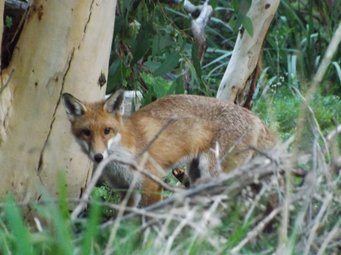Ben Stepkovitch
- MRes Student, Lab of Animal Ecology, Hawkesbury Institute for the Environment, University of Western Sydney
- Topic: Dietary preferences of the European red fox in urban Australia
- Supervisors: Dr J. Welbergen, Dr John Martin, Prof Chris Dickman
- Contact: Ben Stepkovitch
 A red fox at South Head, Sydney Harbour National Park. Photo: Ben Stepkovitch
A red fox at South Head, Sydney Harbour National Park. Photo: Ben Stepkovitch
Bio
My research interests are firmly grounded in conservation. I completed a Bachelor of Advanced Science in Zoology at Western Sydney University in 2015. My undergraduate research projects consisted of studying diet preferences in brushtail possums (Trichosurus vulpecula) and the lactational energetics of red-tailed phascogales (Phascogale calura).
Research:
The European red fox (Vulpes vulpes) was introduced into Australia in the 19th century and has become widely distributed since. They are commonly found in urban areas, yet most of the research of foxes in Australia has focused on foxes in rural and wilderness areas. Little is known about their ecology in urban areas, yet alone how their diet composition changes in areas of different land use.
My research will focus on investigating how the diet composition of foxes in Sydney, Australia, changes across a gradient of land use, moving from the coast to the Blue Mountains in the west. I am interested in determining whether there are areas where foxes are preying upon higher proportions of native species to non-native species. Native species can cling on to refugia in urban environments, and predation by foxes could threaten their persistence.
My project will involve assessing the diet composition of foxes by examining their stomach and intestinal contents from carcasses that have been provided as part of ongoing fox management across the Greater Sydney Region. I will also be examining scats that have been found by land managers and bush regeneration staff.
My research interests are firmly grounded in conservation. I completed a Bachelor of Advanced Science in Zoology at Western Sydney University in 2015. My undergraduate research projects consisted of studying diet preferences in brushtail possums (Trichosurus vulpecula) and the lactational energetics of red-tailed phascogales (Phascogale calura).
Research:
The European red fox (Vulpes vulpes) was introduced into Australia in the 19th century and has become widely distributed since. They are commonly found in urban areas, yet most of the research of foxes in Australia has focused on foxes in rural and wilderness areas. Little is known about their ecology in urban areas, yet alone how their diet composition changes in areas of different land use.
My research will focus on investigating how the diet composition of foxes in Sydney, Australia, changes across a gradient of land use, moving from the coast to the Blue Mountains in the west. I am interested in determining whether there are areas where foxes are preying upon higher proportions of native species to non-native species. Native species can cling on to refugia in urban environments, and predation by foxes could threaten their persistence.
My project will involve assessing the diet composition of foxes by examining their stomach and intestinal contents from carcasses that have been provided as part of ongoing fox management across the Greater Sydney Region. I will also be examining scats that have been found by land managers and bush regeneration staff.

